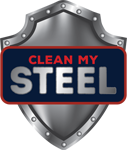I Thought Stainless Steel Wouldn’t Rust! What Happened?
Posted by Eric Goldman on

Stainless steel is used in everything from car parts to cookware to medical devices. As the name implies, it is often touted as “stainless,” which could reasonably be interpreted to mean rust-free. In reality, though, stainless steel can rust. Here’s how.
What Is Rust?
Rust, scientifically known as iron oxide, is the reddish-orange compound created when iron is exposed to oxygen and moisture. It is a form of corrosion, which is a chemical reaction that occurs when one piece of metal (the anode) gives up electrons to another piece of metal (the cathode) in the presence of a liquid known as an electrolyte, which helps electrons move.
In the rusting process, water is the electrolyte. It combines with carbon dioxide from the air, to form a stronger electrolyte known as carbonic acid. When it hits the iron, two things happen: the iron begins to dissolve and some of the water breaks down into hydrogen and oxygen. The newly freed oxygen from the water, along with oxygen from the air, combines with the dissolved iron to form iron oxide—rust. This liberates electrons, allowing them to flow through the electrolyte (the carbonic acid) from the anode (the iron) to the cathode (another spot on the iron or a piece of another metal).
Acid rain, seawater, and salt spray from trucks are even stronger electrolytes. This hastens the corrosion process, causing more and faster-spreading damage.
What Stops Stainless Steel from Rusting?
Stainless steel is not rust-proof, but it is rust-resistant. This is due to how it is made. While steel is composed of iron and carbon, stainless steel also contains chromium (and sometimes other elements as well). Chromium has a strong affinity for oxygen, so exposure causes a layer of chromium oxide to form on the surface of the stainless steel. This thin but strong layer prevents further oxidation, and thus rust, from occurring. Chromium is present throughout the stainless steel, not just on its surface, so even a deep scratch will form its own protective layer of chromium oxide.
Then How Does Stainless Steel Rust?
The key to this mystery lies in the concentration of chromium that must be present to prevent rusting. Chromium concentrations in stainless steel vary from 12% to 30%, with higher quality stainless steel containing more chromium. However, 12% is the minimum concentration that will protect stainless steel.
Corrosive elements such as seawater or certain chemicals can overwhelm typical stainless steel. That’s why marine grade stainless steel adds a small concentration of molybdenum, a highly corrosion-resistant metallic element.
Absent a corrosive environment, the most common cause of rusting in stainless steel is the use of steel wool or another steel tool to clean the stainless steel. Tiny steel particles can come off the tool and cover the stainless steel item. This can overwhelm the localized concentration of chromium in some spots, causing it to drop below 12% and rusting to occur.
Another, somewhat rarer, cause for rusting occurs when the stainless steel is exposed to very high temperatures, as in welding applications. In this case, carbon in the stainless steel can actually bond with the chromium, creating carbides that stabilize at the grain boundaries. This process, known as sensitization, can ruin stainless steel, as the carbides can only be removed through a complex heat treatment.
Preventing and Treating Stainless Steel Rust
Fortunately, most people will never face stainless steel sensitization. Normal rusting can be largely prevented by paying attention to what tools you use on the stainless steel. Avoid steel wool, steel grill tools, and other items that could overwhelm the chromium. Purchasing higher quality stainless steel helps too, as simple math shows that it is far easier to accidentally drop the localized concentration of chromium below 12% in an item that only contains 12% chromium than in an item that contains 30% chromium.
If, despite your best efforts, your stainless steel does develop rust, contact us! At EliminateRust, we sell the best, safest, organic stainless steel rust removers on the market. We can help you return your stainless steel to its original, chromium protected state.
Ready to Get Started?
Ready for a better, safer, organic rust remover? Contact EliminateRust today at 561-410-3636 to learn how we can help.
